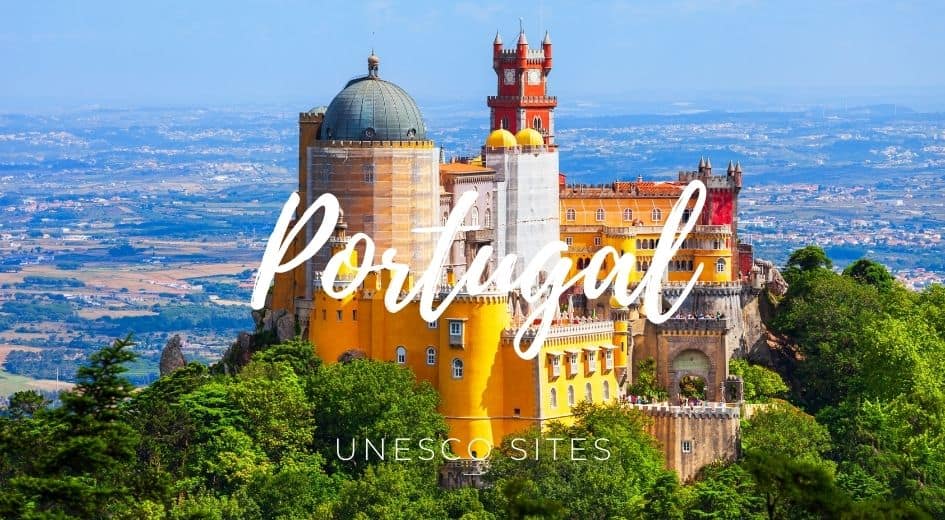Table of Contents

Portugal UNESCO has registered 17 sites on the World Heritage list and 19 on the tentative list.
Some places are so interesting that it’s relevant to keep them for future generations. This is why UNESCO has built a list of crucial classified properties in which superb places stand out for their aesthetic, natural, artistic, or cultural significance.
More than a thousand places are registered as Unesco’s World Heritage worldwide. Due to my interest in visiting World Heritage sites, I compiled the UNESCO list in Portugal and the corresponding map.
Portugal UNESCO list
- Alto Douro Wine Region
- Central Zone of the Town of Angra do Heroismo in the Azores
- Convent of Christ in Tomar
- Cultural Landscape of Sintra
- Garrison Border Town of Elvas and its Fortifications
- Historic Centre of Évora
- Historic Centre of Guimarães
- Historic Centre of Oporto, Luiz I Bridge and Monastery of Serra do Pilar
- Landscape of the Pico Island Vineyard Culture
- Monastery of Alcobaça
- Monastery of Batalha
- Monastery of the Hieronymites and Tower of Belém in Lisbon
- Prehistoric Rock Art Sites in the Côa Valley and Siega Verde
- Royal Building of Mafra – Palace, Basilica, Convent, Cerco Garden and Hunting Park (Tapada)
- Sanctuary of Bom Jesus do Monte in Braga
- University of Coimbra – Alta and Sofia
- Laurisilva of Madeira
Portugal UNESCO Map
Click on the blue pins to view more relevant information about each World Heritage site in Portugal.
Description
- Alto Douro Wine Region – located in northern Portugal, is the world’s oldest wine region and has produced wine for over 2,000 years. It is known for its terraced vineyards, traditional wine-making methods, and the production of port wine.
- Central Zone of the Town of Angra do Heroismo in the Azores – located in the Azores archipelago. It is a well-preserved example of a Renaissance-era town featuring architecture from the 16th and 17th centuries.
- Convent of Christ in Tomar – located in central Portugal is a former Roman Catholic convent and a UNESCO World Heritage Site. It was originally built in the 12th century as a Templar stronghold and later became the headquarters of the Order of Christ.
- Cultural Landscape of Sintra – located in the Lisbon region of Portugal, it is a landscape of castles, palaces, and gardens featuring a mix of Gothic, Manueline, and Moorish architectural styles.
- Garrison Border Town of Elvas and its Fortifications – located in southern Portugal- is a well-preserved example of a military architecture system dating back to the 17th century.
- Historic Centre of Évora – located in southern Portugal- is a well-preserved example of a medieval city featuring Roman, Moorish, and Gothic architecture.
- Historic Centre of Guimarães – located in northern Portugal, it is an exceptionally well-preserved example of a medieval town and is often referred to as the birthplace of Portugal.
- Historic Centre of Oporto, Luiz I Bridge and Monastery of Serra do Pilar – located in northern Portugal, it is a historic center featuring a mix of architectural styles, including Baroque, Gothic, and Romanesque.
- Landscape of the Pico Island Vineyard Culture – located in the Azores archipelago, it is a unique cultural landscape featuring vineyards grown on small plots of land, separated by walls made of basalt.
- Monastery of Alcobaça – located in central Portugal- is a 12th-century Cistercian monastery and one of Portugal’s most significant examples of Gothic architecture.
- Monastery of Batalha – located in central Portugal- is a 14th-century Dominican monastery and a UNESCO World Heritage Site known for ornate Gothic architecture.
- Monastery of the Hieronymites and Tower of Belém in Lisbon – located in the Lisbon region of Portugal- is a 16th-century monastery and a UNESCO World Heritage Site known for its Manueline architecture.
- Prehistoric Rock Art Sites in the Côa Valley and Siega Verde – located in northern Portugal and across the border in Spain, feature rock carvings dating back to the Upper Paleolithic period.
- Royal Building of Mafra – Palace, Basilica, Convent, Cerco Garden, and Hunting Park (Tapada) – located near Lisbon, a Baroque palace and monastery complex built in the 18th century.
- Sanctuary of Bom Jesus do Monte in Braga – located in northern Portugal. It is a Baroque pilgrimage site featuring a monumental stairway and a church.
- University of Coimbra – Alta and Sofia – located in central Portugal, is a historic university founded in the 13th century, featuring a mix of Gothic, Baroque, and Neoclassical architectural styles.
- Laurisilva of Madeira – located on Madeira’s island- is a unique subtropical forest that dates back to the Tertiary period and is known for its diverse plant and animal life.
UNESCO World Heritage Sites in Portugal have protected places for their cultural and natural importance.
Sites on the Tentative List
- Historic Centre of Guimarães and Couros Zone (extension)
- Historical Lisbon, Global City
- Mértola
- Montado, Cultural Landscape
- Route of Magellan. First around the World
- Vila Viçosa, Renaissance ducal town
- Selvagens Islands
- Bulwarked Fortifications of the “Raia” (Border)
- Águas Livres Aqueduct
- Routes of Santiago de Compostela: Routes in Portugal
- Roman Production Centre of Fish Salting and Conservation in Tróia
- Ensemble of Álvaro Siza’s Architecture Works in Portugal
- Southwest Coast
- Pombaline Lisbon
- Desert of the Discalced Carmelites and Built Ensemble of the Palace-Hotel in Bussaco
- Head Office and Garden of the Calouste Gulbenkian Foundation
- Levadas of Madeira Island
- Mid-Atlantic Ridge
- Sites of Globalization


